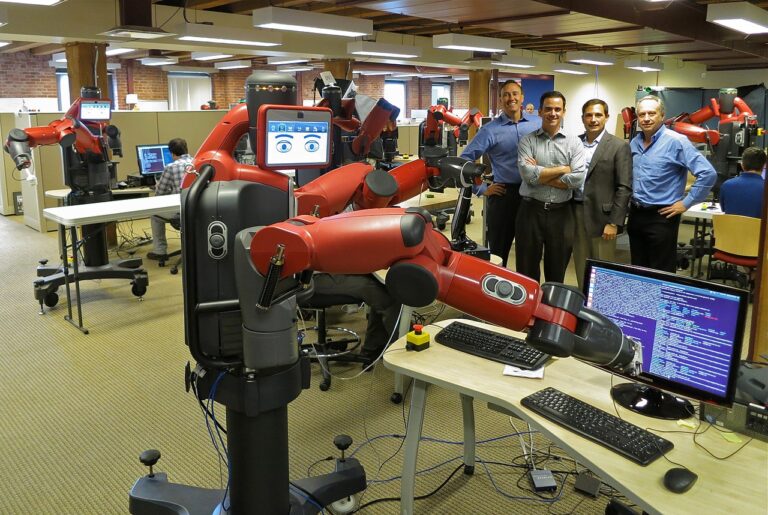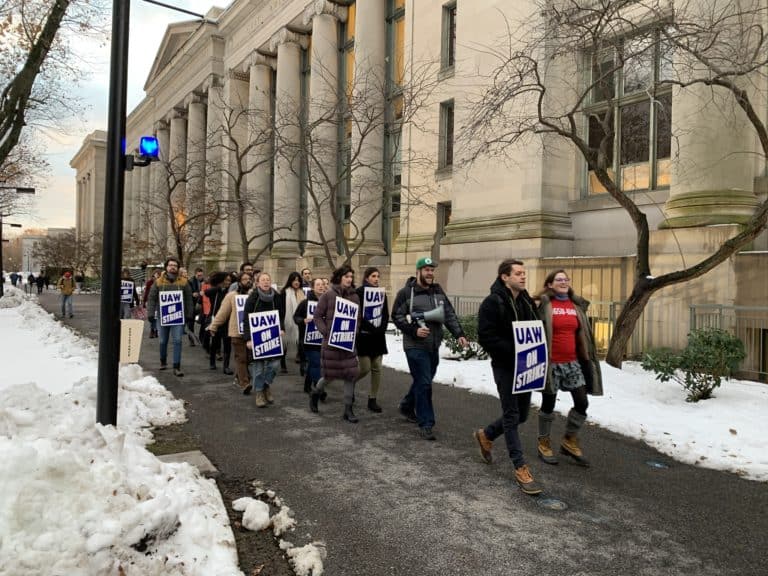
Andrew Dunn is a student at Harvard Law School and a member of the Labor and Employment Lab.
On October 6th, Senate Health, Education, Labor and Pensions Committee Ranking Member Bernie Sanders published The Big Tech Oligarchs’ War Against Workers, a study completed by asking ChatGPT to estimate displacement via catalogued job descriptions, projecting nearly 100 million jobs lost to AI and automation over the next decade. However, views about the likely impact of AI on employment run the gamut: corporate leaders predict “white collar bloodbaths”, while researchers question whether AI poses short-term job-loss risk. Debates and anxiety about AI’s potential disruption of labor markets continue to dominate headlines and decision-makers’ attention.
Job loss from automation, however, is not a new concern. Since the Industrial Revolution, automation has prompted clashes over workers’ protections, shifting job opportunities, and who benefits from innovation. Addressing these questions requires modernizing employment regulations. New York recently updated its state WARN Act regulations to require disclosure when AI automation causes mass layoffs. This is the first state action to require transparency about terminations spurred by AI.
While these notices are a starting point, policymakers must add onto these programs and ensure AI benefits are not solely at a cost to workers. Beyond notification, trade-related economic displacement policy, so-called “trade adjustment assistance,” provides a historical analogue and starting point for bolder support in response to the AI boom.
NY Displacement Notices
New York’s mini-WARN Act is adapted from the federal Worker Adjustment and Retraining Notification (WARN) Act. New York’s stricter law requires employers with 50 or more employees to provide a 90-day notice when a layoff affects 33 percent of their workforce or at least 250 employees from a single jobsite. The notice is sent to all workers and their union, as well as local and state entities like school districts and local elected officials. Following layoffs, WARN notices ensure awareness of unemployment insurance and training opportunities and provide additional time to seek jobs.
In her January 2025 State of the State proposals, Governor Hochul directed the state department of labor to update their WARN system to require employers to select a checkbox in their notice if the closing or layoff was caused by AI. This change enhances transparency and will help New York identify broad-scale automation harm.
Although valuable information is gained from a notice, historical examples from import-related displacement show greater interventions are needed to help workers. Trade economic displacement policy should be the minimum starting point for AI job-loss benefits.
Lessons from Trade-Impacted Job Displacement
In the early 20th century, trade policy relied on theories that protectionist tariffs promote domestic industry and American job security. From the 1950s to the early 2010s, trade policy embraced expanding market access that contributed to declines in U.S. manufacturing and industrial employment.
As with AI displacement, research and expert views vary on the extent of job loss relative to the benefits of removing trade barriers. For example, the Center for Strategic and International Studies projects a net loss of only 3.5 million jobs from trade between 1991 and 2019. But, sectors like the auto industry and manufacturing of electronics, computers, and textiles have suffered trade shocks.
At the start of the free trade era, Congress enacted the Trade Expansion Act of 1962, providing statutory authority for expanding presidential discretion in trade policy and tariff cuts. Congress sought to compensate workers and farmers, balancing the costs and benefits of expanded trade, by creating Trade Adjustment Assistance (TAA).
TAA is available to workers who demonstrate certain criteria affected their job separation (e.g., increase in competitive imports or offshoring production). TAA benefits include extended unemployment insurance, job search and relocation assistance, income support for older workers, and tax credits for health insurance premiums. Potentially critical to the AI context, TAA provides direct payments or vouchers for training when workers cannot access commensurate employment.
TAA, however, has not been a perfect solution for trade-impacted workers, Critics emphasize its limited eligibilityand that these benefits are largely inadequate and retroactive, falling short of the proactive income and retraining support workers deserve. TAA also fluctuated in value: President Reagan cut benefits as part of his welfare reform agenda while President Obama oversaw the last reauthorization and expansion of TAA via a compromise to secure fast-track trade authority. Unfortunately, Congress let TAA expire in June 2022; only workers whose TAA petitions were already approved continue to receive benefits.
Beyond AI Adjustment Assistance
Much like trade, AI displacement can be shaped by policies that balance innovation and adequate protection for workers. A different kind of “triple-A,” AI Adjustment Assistance, could provide substantial support to those affected by automation disruptions. Adapting the benefits of or universalizing TAA — extended unemployment insurance, wage supplements, job search assistance and counseling, and health care coverage – could be crucial support to workers affected by potential AI-driven job losses.
Federal bills propose testing new dislocated worker programs, expanding WIOA, and collecting data on AI job loss. Before TAA’s expiration, Senator Peters proposed extending it to cover automation. But congressional action on AI has been primarily limited to reports and recommendations, and proposals to prevent states from enforcing regulations.
Since substantive federal action on AI has largely failed to materialize, and although Congress is still considering preempting state and local AI regulations, states should follow New York’s lead and begin taking swift action to prepare for a plausible future of mass automation. Currently, 13 states have mini-WARN Acts. These states should adopt New York-like regulations mandating disclosure of AI job displacement.
While TAA might not have been a perfect program and states may struggle to wholesale replace it on their own, legislators interested in building an AI Adjustment Assistance program can learn from TAA. State economic displacement programs could provide eligibility as a direct certification, automatically enrolling workers in TAA-style benefits when they receive a WARN notice. Regardless of whether they have a mini-WARN, workers subject to WARN notices could automatically be enrolled in displacement benefits. Alternatively, states could revamp their unemployment compensationsystems to integrate TAA-style benefits.
Direct certification of those affected by mass layoffs or plant closings falls into the same trap of retroactive solutions. State legislatures should proactively implement programs to help workers adapt and survive before and following job loss. States could use licensing authorities to require an AI labor impact assessment, like an Environmental Impact Statement, before a business implements AI and mandate mitigation planning as part of the assessment. Others have suggested more radical shifts: reducing work weeks and, as AI reduces need for workers, universal basic incomerather than retraining as the basis of economic displacement policy.
Broadened economic displacement policy would require dramatic investment by states. Reflecting the cost balancing that was at the core of TAA, states could condition licensure of AI companies on fees to support enhanced displacement benefits.
In fighting to protect workers from trade-related job displacement, AFL-CIO President Richard Trumka sought strengthened labor standards and expanding TAA as fundamental to approvals of new trade deals. Trumka argued for TAA by declaring: “When workers lose their jobs through no fault of their own, they need the support of this program.” When workers lose their jobs through no fault of their own because of AI, they deserve the support of another program.










Daily News & Commentary
Start your day with our roundup of the latest labor developments. See all
November 25
In today’s news and commentary, OSHA fines Taylor Foods, Santa Fe raises their living wage, and a date is set for a Senate committee to consider Trump’s NLRB nominee. OSHA has issued an approximately $1.1 million dollar fine to Taylor Farms New Jersey, a subsidiary of Taylor Fresh Foods, after identifying repeated and serious safety […]
November 24
Labor leaders criticize tariffs; White House cancels jobs report; and student organizers launch chaperone program for noncitizens.
November 23
Workers at the Southeastern Pennsylvania Transportation Authority vote to authorize a strike; Washington State legislators consider a bill empowering public employees to bargain over workplace AI implementation; and University of California workers engage in a two-day strike.
November 21
The “Big Three” record labels make a deal with an AI music streaming startup; 30 stores join the now week-old Starbucks Workers United strike; and the Mine Safety and Health Administration draws scrutiny over a recent worker death.
November 20
Law professors file brief in Slaughter; New York appeals court hears arguments about blog post firing; Senate committee delays consideration of NLRB nominee.
November 19
A federal judge blocks the Trump administration’s efforts to cancel the collective bargaining rights of workers at the U.S. Agency for Global Media; Representative Jared Golden secures 218 signatures for a bill that would repeal a Trump administration executive order stripping federal workers of their collective bargaining rights; and Dallas residents sue the City of Dallas in hopes of declaring hundreds of ordinances that ban bias against LGBTQ+ individuals void.